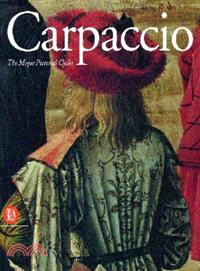Carpaccio—The Major Pictorial Cycles
商品資訊
ISBN13:9788881187379
出版社:Random House Inc
作者:Stefania Mason Rinaldi; Andrew Ellis (TRN); Stefania Mason; Vittore Carpaccio
出版日:2000/10/01
裝訂/頁數:精裝/222頁
規格:27.9cm*24.8cm*1.9cm (高/寬/厚)
商品簡介
作者簡介
相關商品
商品簡介
In this book the native Venetian art scholar Stefania Mason takes the reader through a critical appraisal of the painter Vittore Carpaccio, focusing primarily on the four superb cycles of paintings he executed under commission from the city's confraternities between 1490 and 1520. What emerges from the author's insightful analysis is Carpaccio's unerring vision of the Venice of his times, deftly woven with complex allegorical allusions to create vast narrative tableaux that catered to the Venetian institutions' keen awareness of the power of imagery.
The study begins with the fabled Life of St Ursula cycle (1490-c. 1498), now in the Gallerie dell'Accademia in Venice, in which Carpaccio shows his skilled handling of perspective, endowing his canvases with a mixture of recognisable townscapes and imaginary landmarks of medieval stamp, whose visual cues include personages, gestures, customs and ceremonies in a rhythmical interweaving of reality and legend. Next comes the cycle executed for the Scuola di San Giorgio degli Schiavoni (1502-c. 1507), featuring Sts George, Triphun and Jerome, in which an errant knight and a hermit saint lead the observer into a mythical Orient. The masterpiece of the series is the Vision of St Augustine, where the saint is alone in his study and the disembodied spirit of St Jerome enters by the window in the form of brilliant light illuminating the entire room with its domestic minutiae and panoply of humanistic attributes.
No longer in situ but dispersed among various museums are the last two series carried out by Carpaccio, this time with assistants: the Life of the Virgin cycle for the Scuola degli Albanesi (1502-c. 1507); and the set depicting the Life of St Stephen for the scuola dedicated to the saint (1511-20), a remarkable eulogy to stone and its manifold uses in building and sculpture (many of the confraternity's members were stonemasons). The selection of details and close analysis of Carpaccio's canvases afford a cogent visual guide and critical assessment of this great master of Renaissance painting.
The study begins with the fabled Life of St Ursula cycle (1490-c. 1498), now in the Gallerie dell'Accademia in Venice, in which Carpaccio shows his skilled handling of perspective, endowing his canvases with a mixture of recognisable townscapes and imaginary landmarks of medieval stamp, whose visual cues include personages, gestures, customs and ceremonies in a rhythmical interweaving of reality and legend. Next comes the cycle executed for the Scuola di San Giorgio degli Schiavoni (1502-c. 1507), featuring Sts George, Triphun and Jerome, in which an errant knight and a hermit saint lead the observer into a mythical Orient. The masterpiece of the series is the Vision of St Augustine, where the saint is alone in his study and the disembodied spirit of St Jerome enters by the window in the form of brilliant light illuminating the entire room with its domestic minutiae and panoply of humanistic attributes.
No longer in situ but dispersed among various museums are the last two series carried out by Carpaccio, this time with assistants: the Life of the Virgin cycle for the Scuola degli Albanesi (1502-c. 1507); and the set depicting the Life of St Stephen for the scuola dedicated to the saint (1511-20), a remarkable eulogy to stone and its manifold uses in building and sculpture (many of the confraternity's members were stonemasons). The selection of details and close analysis of Carpaccio's canvases afford a cogent visual guide and critical assessment of this great master of Renaissance painting.
In this book the native Venetian art scholar Stefania Mason takes the reader through a critical appraisal of the painter Vittore Carpaccio, focusing primarily on the four superb cycles of paintings he executed under commission from the city's confraternities between 1490 and 1520. What emerges from the author's insightful analysis is Carpaccio's unerring vision of the Venice of his times, deftly woven with complex allegorical allusions to create vast narrative tableaux that catered to the Venetian institutions' keen awareness of the power of imagery.
The study begins with the fabled Life of St Ursula cycle (1490-c. 1498), now in the Gallerie dell'Accademia in Venice, in which Carpaccio shows his skilled handling of perspective, endowing his canvases with a mixture of recognisable townscapes and imaginary landmarks of medieval stamp, whose visual cues include personages, gestures, customs and ceremonies in a rhythmical interweaving of reality and legend. Next comes the cycle executed for the Scuola di San Giorgio degli Schiavoni (1502-c. 1507), featuring Sts George, Triphun and Jerome, in which an errant knight and a hermit saint lead the observer into a mythical Orient. The masterpiece of the series is the Vision of St Augustine, where the saint is alone in his study and the disembodied spirit of St Jerome enters by the window in the form of brilliant light illuminating the entire room with its domestic minutiae and panoply of humanistic attributes.
No longer in situ but dispersed among various museums are the last two series carried out by Carpaccio, this time with assistants: the Life of the Virgin cycle for the Scuola degli Albanesi (1502-c. 1507); and the set depicting the Life of St Stephen for the scuola dedicated to the saint (1511-20), a remarkable eulogy to stone and its manifold uses in building and sculpture (many of the confraternity's members were stonemasons). The selection of details and close analysis of Carpaccio's canvases afford a cogent visual guide and critical assessment of this great master of Renaissance painting.
The study begins with the fabled Life of St Ursula cycle (1490-c. 1498), now in the Gallerie dell'Accademia in Venice, in which Carpaccio shows his skilled handling of perspective, endowing his canvases with a mixture of recognisable townscapes and imaginary landmarks of medieval stamp, whose visual cues include personages, gestures, customs and ceremonies in a rhythmical interweaving of reality and legend. Next comes the cycle executed for the Scuola di San Giorgio degli Schiavoni (1502-c. 1507), featuring Sts George, Triphun and Jerome, in which an errant knight and a hermit saint lead the observer into a mythical Orient. The masterpiece of the series is the Vision of St Augustine, where the saint is alone in his study and the disembodied spirit of St Jerome enters by the window in the form of brilliant light illuminating the entire room with its domestic minutiae and panoply of humanistic attributes.
No longer in situ but dispersed among various museums are the last two series carried out by Carpaccio, this time with assistants: the Life of the Virgin cycle for the Scuola degli Albanesi (1502-c. 1507); and the set depicting the Life of St Stephen for the scuola dedicated to the saint (1511-20), a remarkable eulogy to stone and its manifold uses in building and sculpture (many of the confraternity's members were stonemasons). The selection of details and close analysis of Carpaccio's canvases afford a cogent visual guide and critical assessment of this great master of Renaissance painting.
作者簡介
Born in Venice, Stefania Mason teaches Art History at the University of Udine, Italy, where she is coordinator for doctorates in research and heads specialisation courses in art history. Her work focuses principally on painting and drawing, on the relationship between art, devotion, and patronage, and on Venetian collecting from the 1400s to the 1600s. Among her numerous publications is a monograph on Palma Giovane (1984).
A noted art scholar specialised in the history of Venetian painting and sculpture from the 1400s to 1600s, Linda Borean is a regular contributor to leading art journals, including Arte Veneta and The Burlington Magazine.
A noted art scholar specialised in the history of Venetian painting and sculpture from the 1400s to 1600s, Linda Borean is a regular contributor to leading art journals, including Arte Veneta and The Burlington Magazine.
主題書展
更多
主題書展
更多書展今日66折
您曾經瀏覽過的商品
購物須知
外文書商品之書封,為出版社提供之樣本。實際出貨商品,以出版社所提供之現有版本為主。部份書籍,因出版社供應狀況特殊,匯率將依實際狀況做調整。
無庫存之商品,在您完成訂單程序之後,將以空運的方式為你下單調貨。為了縮短等待的時間,建議您將外文書與其他商品分開下單,以獲得最快的取貨速度,平均調貨時間為1~2個月。
為了保護您的權益,「三民網路書店」提供會員七日商品鑑賞期(收到商品為起始日)。
若要辦理退貨,請在商品鑑賞期內寄回,且商品必須是全新狀態與完整包裝(商品、附件、發票、隨貨贈品等)否則恕不接受退貨。
























